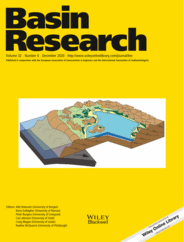
Full text loading...
 , Shu Jiang3,4, Shihu Wu5, Wei Xu6
, Shu Jiang3,4, Shihu Wu5, Wei Xu6 , Jiong Zhang6, Renpeng Feng1, Meihua Yang1, Yongshui Zhou7, M. Santosh8,9,10
, Jiong Zhang6, Renpeng Feng1, Meihua Yang1, Yongshui Zhou7, M. Santosh8,9,10
The Chagan Depression in the Yingen‐Ejinaqi Basin, located at the intersection of the Paleo‐Asian Ocean and the Tethys Ocean domains is an important region to gain insights on terrestrial heat flow, lithospheric thermal structure and deep geodynamic processes. Here, we compute terrestrial heat flow values in the Chagan Depression using a large set of system steady‐state temperature data from four representative wells and rock thermal conductivity. We also estimate the “thermal” lithospheric thickness, mantle heat flow, ratio of mantle heat flow to surface heat flow and Moho temperature to evaluate the regional tectonic framework and deep dynamics. The results show that the heat flow in the Chagan Depression ranges from 66.5 to 69.8 mW/m2, with an average value of 68.3 ± 1.2 mW/m2. The Chagan Depression is characterized by a thin “thermal” lithosphere, high mantle heat flow, and high Moho temperature, corresponding to the lithospheric thermal structure of “cold mantle and hot crust” type. We correlate the formation of the Yingen‐Ejinaqi Basin to the Early Cretaceous and Cenozoic subduction of the western Pacific Plate and the Cenozoic multiple extrusions. Our results provide new insights into the thermal structure and dynamics of the lithospheric evolution in central China.
,System steady‐state temperature data measurements for typical wells in the Chagan Depression.

Article metrics loading...

Full text loading...
References


Data & Media loading...

